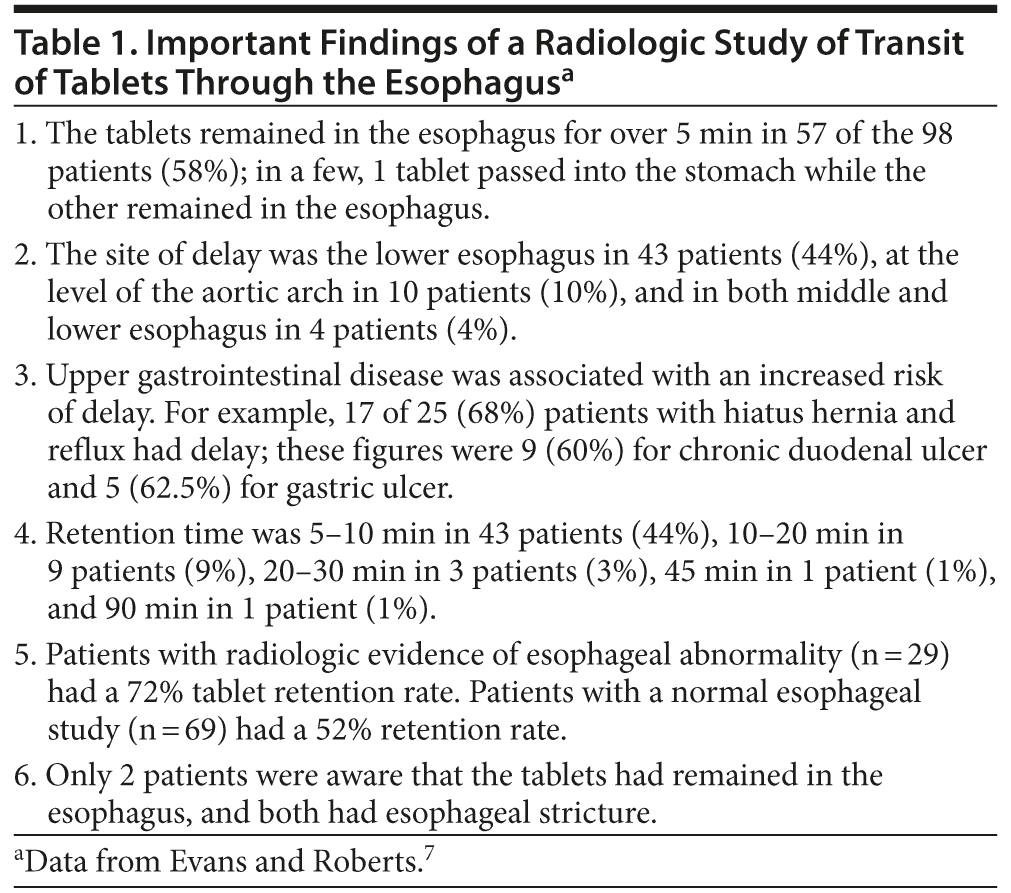
- If pills are swallowed with little or no water, or if the patient lies down immediately after swallowing the pills, esophageal transit of the pills may be delayed; this can cause pill esophagitis, a preventable condition that is commoner in elderly subjects.
- Pill esophagitis can also occur in conditions associated with narrowing of the esophageal lumen. Pill esophagitis is more likely with medications such as iron, alendronate, aspirin, anti-inflammatory drugs, antibiotics, and antimalarials.
- The risk of pill esophagitis can be reduced by swallowing the pill with sufficient water, taking the pill before or during a meal, and staying upright for 15-30 minutes after pill ingestion. If these precautions are difficult to follow, administration of liquid formulations, orodispersible tablets, or crushed tablets can lower the risk.
Clinical Background
In developed but more especially in developing countries, patients with major mental illness may suffer from nutritional deficiencies and may require iron supplements as part of nutritional correction efforts. Iron deficiency and psychiatric disorders may be related; for example, a large, pediatric, population-based study1 found that iron deficiency was associated with mood disorders, autism spectrum disorder, attention-deficit/hyperactivity disorder, and developmental disorders. Iron levels may be low in schizophrenia patients, especially those who develop akathisia.2 Low iron levels have also been associated with geriatric3 and perinatal4 depression. Iron supplementation may be necessary in patients with restless legs syndrome.5 Finally, women with psychiatric illness may experience menstrual disturbances; if there is chronically increased menstrual flow, anemia may result and neuropsychological deficits may manifest.6 The preceding description of the role of iron in psychiatry is not comprehensive; it merely serves to draw attention to situations in which iron supplementation may be considered in patients with psychiatric disorders.
Patients receiving oral iron therapy are required to avoid lying down for 15-30 minutes after ingesting the medication. This and certain other precautions related to medication ingestion may, in fact, be desirable with many other medications, as well. What are the precautions, why are they necessary, and for which medications? Whereas gastroenterologists have long known of these matters, psychiatrists should also be aware of them because patients who receive iron supplements (and other medications requiring such precautions) may not read or may be unable to read the guidance in package inserts and may lack access to pharmacists who will provide the necessary advice at the time of dispensing the medications.
Evidence for Delayed Transit of Tablets Through the Esophagus
Nearly 4 decades ago, Evans and Roberts7 remarked that the sensation of swallowed tablets “sticking” in the esophagus is common; in fact, one of the authors had personally experienced dysphagia after ingesting an antimalarial tablet. These authors therefore conducted a simple study to determine how often tablets stick in the esophagus and the site at which the tablets lodge.
They7 administered barium sulfate tablets to 98 consecutive patients (57% male) who were undergoing a routine radiologic study of the gastrointestinal tract; no patient had known obstructive esophageal disease. The tablets were identical in size and shape to the common aspirin tablet. Each patient received 2 tablets along with just enough water (15 mL) to assist swallowing. The patients were asked to lie down immediately after swallowing the tablets and were subjected to fluoroscopic examination in the supine position. If the tablets remained in the esophagus for more than 5 minutes, the patients were asked to stand and were then reexamined at 10-minute intervals until the tablets entered the stomach.
The findings of the study7 are summarized in Table 1. Esophageal retention of tablets for > 5 minutes was observed in 58% of the sample. Upper gastrointestinal disease was a risk factor for tablet retention; however, tablet retention was also observed in more than half of patients with a normal esophageal study. Of the 2 patients with the longest esophageal transit time, 1 had no radiologic diagnosis (transit time = 45 minutes), and the other had an esophageal stricture (transit time = 90 minutes).
Evans and Roberts7 reported that they also had evidence of esophageal retention of capsules and of tablets smaller than the ones administered in their study. A limitation of their study is that it was conducted in patients who had been referred for radiologic investigation and who, consequently, would be more likely to show tablet retention. Another limitation is that the patients had been allowed only 15 mL of water to help them swallow their tablets. A strength of this study is that it illustrates risks in patients with known or suspected upper gastrointestinal disease and in those who habitually swallow their medications with little or no water and who lie down afterward.
Implications of Delayed Transit Through the Esophagus
Esophageal retention of a swallowed pill will delay absorption and hence the onset of action of the medication. This issue may not be clinically relevant with most medications and in most situations, particularly in psychiatric practice. More importantly, if a pill is lodged in the esophagus, it may cause local irritation and ulceration. This condition is known as pill-induced esophagitis or just pill esophagitis, an underreported condition that is well known to gastroenterologists and underrecognized by other medical specialists.8-10
Patients who experience pill esophagitis commonly only suffer sudden-onset retrosternal pain. Although this pain is usually self-limiting, it can persist for several days in association with dysphagia. In some cases, esophageal hemorrhage, stricture, and perforation may occur, and fatality is a rare but possible outcome.8-10
Iron-containing medications have long been known to cause pill esophagitis. Initiation or exacerbation of esophageal and gastric lesions by iron has been histologically demonstrated,11,12 and fatality has been reported.11 In a prospective endoscopic study of the upper gastrointestinal tract, Kaye et al13 found that 15 of 93 (16%) patients receiving oral iron tablets had iron deposits evident on routine hematoxylin and eosin staining. Pooling these with data obtained from a retrospective data set, they found that, of patients with esophageal iron deposit, 6 of 7 (86%) had associated erosion; of patients with gastric iron deposit, 29 of 46 (63%) had erosion and 37 (80%) had reactive gastritis.
Other pills that can cause painful erosions if they lodge temporarily in the esophagus include those that contain aspirin or nonsteroidal anti-inflammatory drugs, alendronate, doxycycline, tetracycline, macrolide antibiotics, antimalarials, and potassium.8-10,14 In psychiatry, pill esophagitis has been reported with fluoxetine.15 In fact, a large review8 described pill esophagitis in association with nearly a hundred different medications in 979 patients. The management of pill esophagitis was summarized by Kikendall.9
Risk Factors for Pill Esophagitis
In a histopathologic study of 12 patients with iron-related esophageal ulceration, Serck-Hanssen and Stray11 observed that all patients were elderly and most were bedridden. Greater age may be associated with less efficient esophageal motility, and gravitational assistance to esophageal transit of medication might be diminished in the supine position. Thus, greater age and supine posture may be 2 predispositions to pill esophagitis.9
Patients in the Evans and Roberts7 study ingested their tablets with very little water; this, therefore, is also likely to be a risk factor.9 The authors7 showed that esophageal retention of tablets is common even in patients who are upright after the first 5 minutes; one wonders how much more frequent or prolonged the retention might have been if the patients were supine throughout the period of observation. Given that the patients were required to lie supine for the first 5 minutes, another possible implication is that once a tablet is impacted in the esophagus, it is not easily dislodged. This suggests the need for patients to remain upright for a short while after swallowing a tablet or capsule.
Anything that physically or physiologically impairs esophageal transit could increase the risk of pill esophagitis. Examples include disorders of esophageal motility, left atrial enlargement with resultant esophageal compression, hiatus hernia, and esophageal stricture.8-10,14 Pill esophagitis may also be commoner with capsules, sustained-release formulations, and large or oddly shaped pills.10
Guidance
Given the literature that has been reviewed, the following recommendations are reasonable7-10:
- Tablets and capsules should be swallowed with a full glass of water so that the water will carry the medication into the stomach along with the peristaltic waves.
- Tablets and capsules should be ingested before or during a meal rather than after the meal so that the food will mechanically carry the medication into the stomach along with the peristaltic waves. This recommendation, of course, will not apply to medications that are specifically advised to be taken on an empty stomach; thyroxine is one such example.16
- Patients should not lie down for at least 15-30 minutes after ingesting a tablet or capsule; peristaltic movement of the medication into the stomach may be aided by gravity if the medication has not already entered the stomach with the assistance of water and food, as described above. Patients receiving hypnotic drug therapy are usually asked to go to bed immediately after taking their medication. Whereas hypnotic drugs have not generally been associated with pill esophagitis, it could be good practice even for such patients to wait for about 5 minutes before lying down.
- These recommendations are especially relevant to medications that can damage the esophagus, such as iron, aspirin, anti-inflammatory drugs, alendronate, potassium, tetracyclines, macrolide antibiotics, and antimalarials.8-10
- In some patients, these recommendations may not be implementable. For example, patients receiving electroconvulsive therapy (ECT) are allowed only a sip of water when they take their essential medications on the morning of an ECT session. Or, patients who are confined to bed may not be able to drink much or eat, nor may they be able to remain upright after ingesting their medications. Therefore, wherever possible, such patients should receive liquid, chewable, or mouth-dissolving (orodispersible) formulations or formulations that can be crushed before administration with water.
Concluding Notes
Pill esophagitis is a preventable condition. Providing the necessary guidance to the patient in order to minimize the risk of this condition should take less than a minute.
J Clin Psychiatry 2013;74(10):e949-e951 (doi:10.4088/JCP.13f08766)
© Copyright 2013 Physicians Postgraduate Press, Inc.
 Each month in his online column, Dr Andrade considers theoretical and practical ideas in clinical psychopharmacology with a view to update the knowledge and skills of medical practitioners who treat patients with psychiatric conditions.
Each month in his online column, Dr Andrade considers theoretical and practical ideas in clinical psychopharmacology with a view to update the knowledge and skills of medical practitioners who treat patients with psychiatric conditions.
Department of Clinical Psychopharmacology and Neurotoxicology, National Institute of Mental Health and Neurosciences, Bangalore, India ([email protected]).
Financial disclosure and more about Dr Andrade.
REFERENCES
1. Chen MH, Su TP, Chen YS, et al. Association between psychiatric disorders and iron deficiency anemia among children and adolescents: a nationwide population-based study. BMC Psychiatry. 2013;13(1):161. PubMed doi:10.1186/1471-244X-13-161
2. Kuloglu M, Atmaca M, Ustündag B, et al. Serum iron levels in schizophrenic patients with or without akathisia. Eur Neuropsychopharmacol. 2003;13(2):67-71. PubMed doi:10.1016/S0924-977X(02)00073-1
3. Stewart R, Hirani V. Relationship between depressive symptoms, anemia, and iron status in older residents from a national survey population. Psychosom Med. 2012;74(2):208-213. PubMed doi:10.1097/PSY.0b013e3182414f7d
4. Leung BM, Kaplan BJ. Perinatal depression: prevalence, risks, and the nutrition link: a review of the literature. J Am Diet Assoc. 2009;109(9):1566-1575. PubMed doi:10.1016/j.jada.2009.06.368
5. Picchietti MA, Picchietti DL. Advances in pediatric restless legs syndrome: iron, genetics, diagnosis and treatment. Sleep Med. 2010;11(7):643-651. PubMed doi:10.1016/j.sleep.2009.11.014
6. Murray-Kolb LE. Iron status and neuropsychological consequences in women of reproductive age: what do we know and where are we headed? J Nutr. 2011;141(4):747S-755S. PubMed doi:10.3945/jn.110.130658
7. Evans KT, Roberts GM. Where do all the tablets go? Lancet. 1976;2(7997):1237-1239. PubMed doi:10.1016/S0140-6736(76)91158-2
8. Kikendall JW. Pill esophagitis. J Clin Gastroenterol. 1999;28(4):298-305. PubMed doi:10.1097/00004836-199906000-00004
9. Kikendall JW. Pill-induced esophagitis. Gastroenterol Hepatol (N Y). 2007;3(4):275-276. PubMed
10. Arora AS, Murray JA. Iatrogenic esophagitis. Curr Gastroenterol Rep. 2000;2(3):224-229. PubMed doi:10.1007/s11894-000-0065-1
11. Serck-Hanssen A, Stray N. Esophageal lesions induced by iron tablets. Tidsskr Nor Laegeforen. 1994;114(18):2129-2131. PubMed
12. Eckstein RP, Symons P. Iron tablets cause histopathologically distinctive lesions in mucosal biopsies of the stomach and esophagus. Pathology. 1996;28(2):142-145. PubMed doi:10.1080/00313029600169763
13. Kaye P, Abdulla K, Wood J, et al. Iron-induced mucosal pathology of the upper gastrointestinal tract: a common finding in patients on oral iron therapy. Histopathology. 2008;53(3):311-317. PubMed doi:10.1111/j.1365-2559.2008.03081.x
14. Glenn SM, Parakh K. Education and imaging. Gastrointestinal: pill esophagitis. J Gastroenterol Hepatol. 2008;23(2):339. PubMed doi:10.1111/j.1440-1746.2007.05304.x
15. Wani AM, Shiekh AG, Hussain WM, et al. Fluoxetine-induced pill oesophagitis. BMJ Case Rep. 2011. PubMed doi:10.1136/bcr.09.2010.3333
16. Andrade C. Levothyroxine in psychiatry: issues related to absorption after oral dosing. J Clin Psychiatry. 2013;74(8):e744-e746.


 Each month in his online column, Dr Andrade considers theoretical and practical ideas in clinical psychopharmacology with a view to update the knowledge and skills of medical practitioners who treat patients with psychiatric conditions.
Each month in his online column, Dr Andrade considers theoretical and practical ideas in clinical psychopharmacology with a view to update the knowledge and skills of medical practitioners who treat patients with psychiatric conditions.




